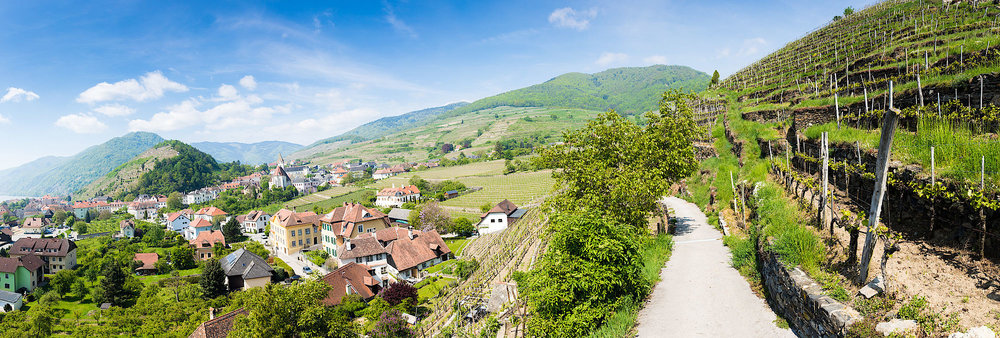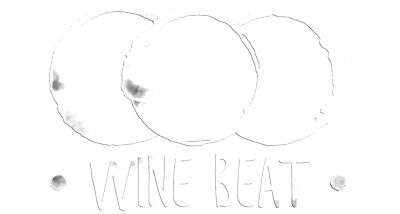
The Wachau is a UNESCO world heritage site and here is how UNESCO describes its essential attractiveness: “The Wachau is a stretch of the Danube located between Melk and Krems, which demonstrates high visual and landscape qualities. It showcases many intact and visible traces of its continuous, organic evolution since prehistoric times, be it in terms of architecture (monasteries, castles, ruins), urban design (towns and villages), or agricultural use (mainly for the cultivation of vines and apricot trees)”. In short, a place where humans have worked marvelous adornments to an already sublimely beautiful place.
Starting in the 800’s, monasteries went to work to build robust and handsome stone terraces. Over the centuries these have served as the foundations for agriculture (practiced on a micro, terrace-by-terrace basis) and also the foundation for the economies of the small villages that sprang up all along the Danube. This is a minutely differentiated patchwork. Winegrowers have seized upon all of these myriad individual plots to not only grow grapes and make wine – but to also define different styles and qualities of wine. And classification systems and regulatory regimes have inevitably followed.
Austrian Efficiency and Austrian Wine Organization
The Austrians are nothing if not organized. At the top level of the classification system, there is of course good old-fashioned geographic designation. The Wachau is one of 8 recognized sub-regions within the larger Niederöstereich (Lower Austria) region. Then there is the classification of wines within the Wachau. In 1983 several winemakers created the Vinea Wachau Nobilis Districtus to define categories of wine and came up with 3 classes of dry white wine based, essentially, on alcohol content:. (1) wines up to 11.5% are called Steinfeder; (2) wines from 11.5% to 12.5% are called Federspiel; and (3) wines from late harvest with minimum 13.5% alcohol are designated Smaragd. Then there are the individual vineyard soils, inclines, aspects and microclimates.
It is a universe unto itself and when you see the winding Danube valley and the terraces and all of the diversity in this small area, then it becomes clear what microcosms there are within microcosms. Wouldn’t anybody be tempted to try to define and to catalogue them?
Where is Wachau?

Niederöstereich (Lower Austria) is the largest wine producing region of Austria and is made up of 8 recognized wine subregions. These can be roughly divided into three climatic zones, one of which stretches along the Danube River valley immediately to the west of Vienna. This is where the Wachau sub-region is located, on the flanks of the Danube valley between the villages of Melk and Krems. There is an impossibly pretty set of villages dotted along the Danube as you travel west from Vienna. Wine touring here will seem slightly other-worldly and surreal because of the sheer beauty. The stone terraces, the painstaking handiwork of the monks over many centuries, impose a unique, man-made structural element over top of the natural contours of the valley. There is a wonderful interplay between the eons-old geology that forms the bedrock and soils for the vines, the age-old wooded river valley that creates the backdrop and, the centuries-old work of man that has tamed this place for the vine.
When we zoom out a little bit we can appreciate where this region sits in the broader geography of Europe. Niederöstereich is near the eastern end of Austria. Slovakia, Czech Republic, Hungary and Slovenia are all a stone’s throw away. In fact the Niedöstereich’s largest sub-region, Weinviertel, borders Slovakia and Czech. Its name means “wine quarter”. To be so near Vienna has been a boon both to the winegrowers and to Vienna over the centuries since there is a ready wine supply and a willing wine market. It’s worth noting that the city of Vienna has its own, eponymous wine region – the only major European capital to have a wine region within its city limits.
Who could possibly need any more reason to visit Vienna and the Wachau?
Why Wachau for Wine?

In Wachau, home to some of Austria’s most famous vineyards, Grüner Veltliner and Rieslings are the dominant grapes. Rocky soils of gneiss, quartz, gravel and sand provide a hard-scrabble source of nourishment for the vines. And the site-specific differences in each terrace vineyard imbue them with unique definition. This makes for age-worthy, single-vineyard wines. In recent years Grüner Veltliner has, deservedly, become a major darling of the somm crowd and of adventurous wine drinkers seeking exciting wines. Fortunately, many of the most delicious wines remain affordable and Wachau wines are a highly-recommended target when you are in the wine store.

Grüner Veltliner is characterized often by comparison to its better known cousin, Riesling. GV will tend to be more round in mouthfeel, a little less acidic and a little more complex sometimes in terms of spicey notes. Riesling is just that little bit more bright and zingy with acidity. But of course the differences cannot be generalized, especially since there are different classifications (as noted above) based on alcohol content and there are those endless different vineyard expressions. Even distinguishing the two varieties visually is difficult (see pictures).
Who are the Winemakers?
Given the immense diversity of vineyards and the long history of this region it is not surprising that there are a large number of individual vineyards. There are well over 200 in fact and that is a lot given the size of the area. See what is available in your local wine store but a few recommended winemakers with reasonably priced wines are:
When to Visit?
Given the proximity of Vienna and also the ski resorts of the Austrian Alps, anytime is a good time to visit this region. It is incredibly beautiful winter, spring, summer and fall. The autumn colours are a particularly attractive feature at a time of the year when tourist numbers are lower.
Useful Links:
Note there is an app called “mywachau” that gives detailed info on the wineries (“heuriger”) that can be visited and is apparently an excellent tool for managing your visit.

Photos and maps courtesy of www.austianwine.com
